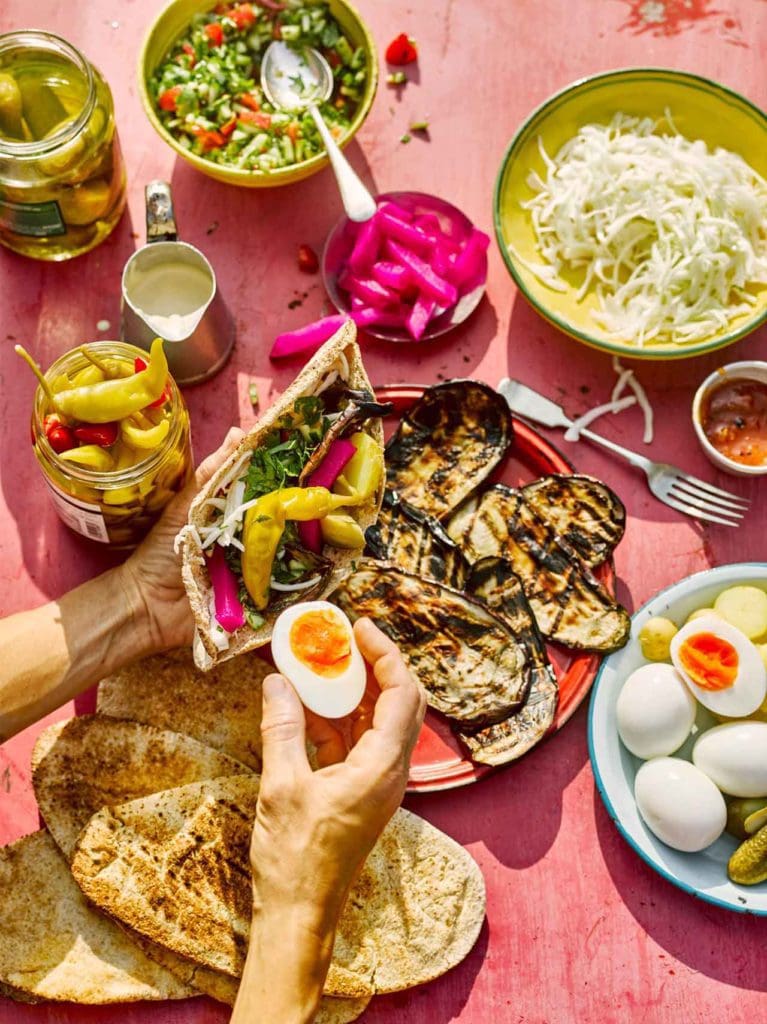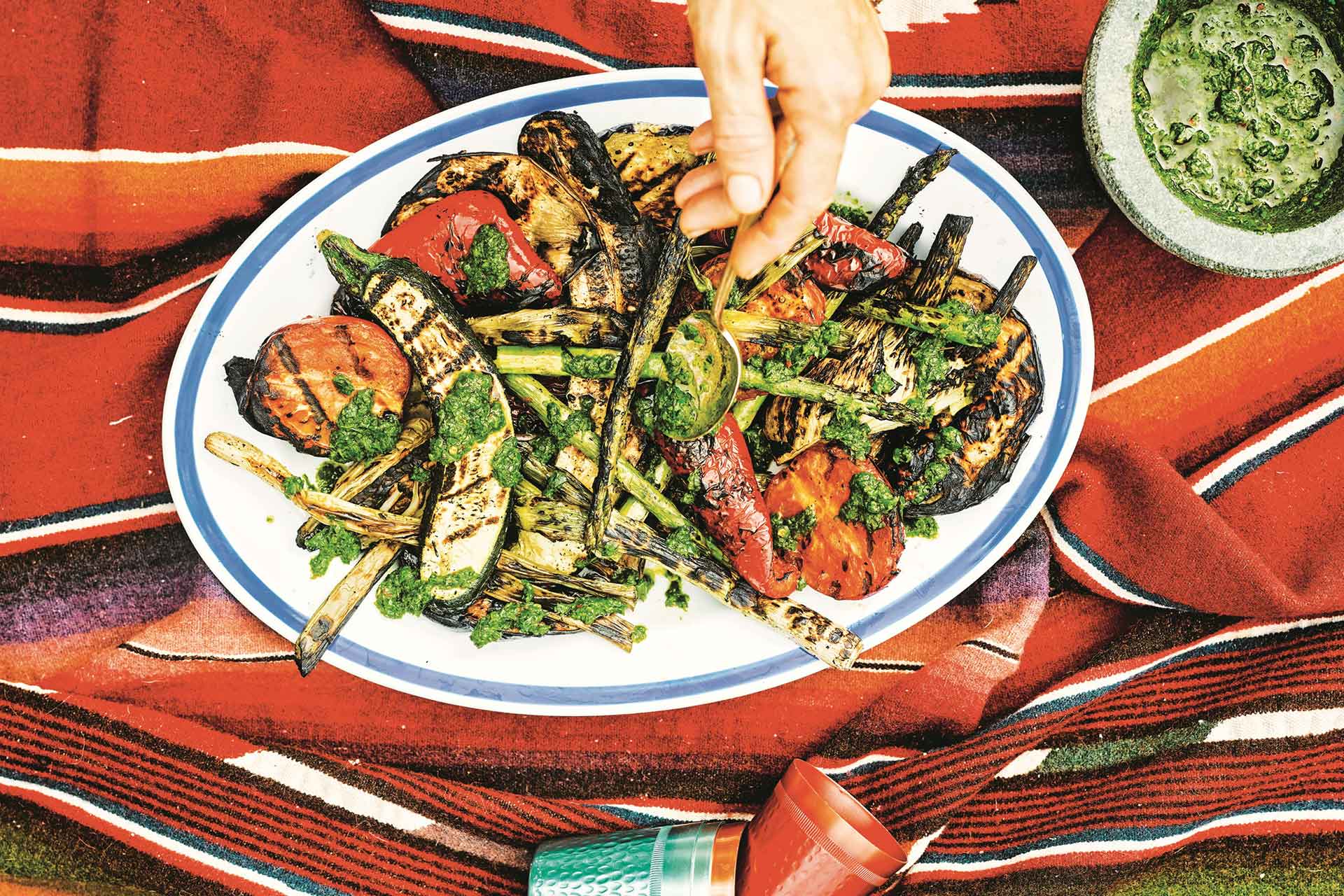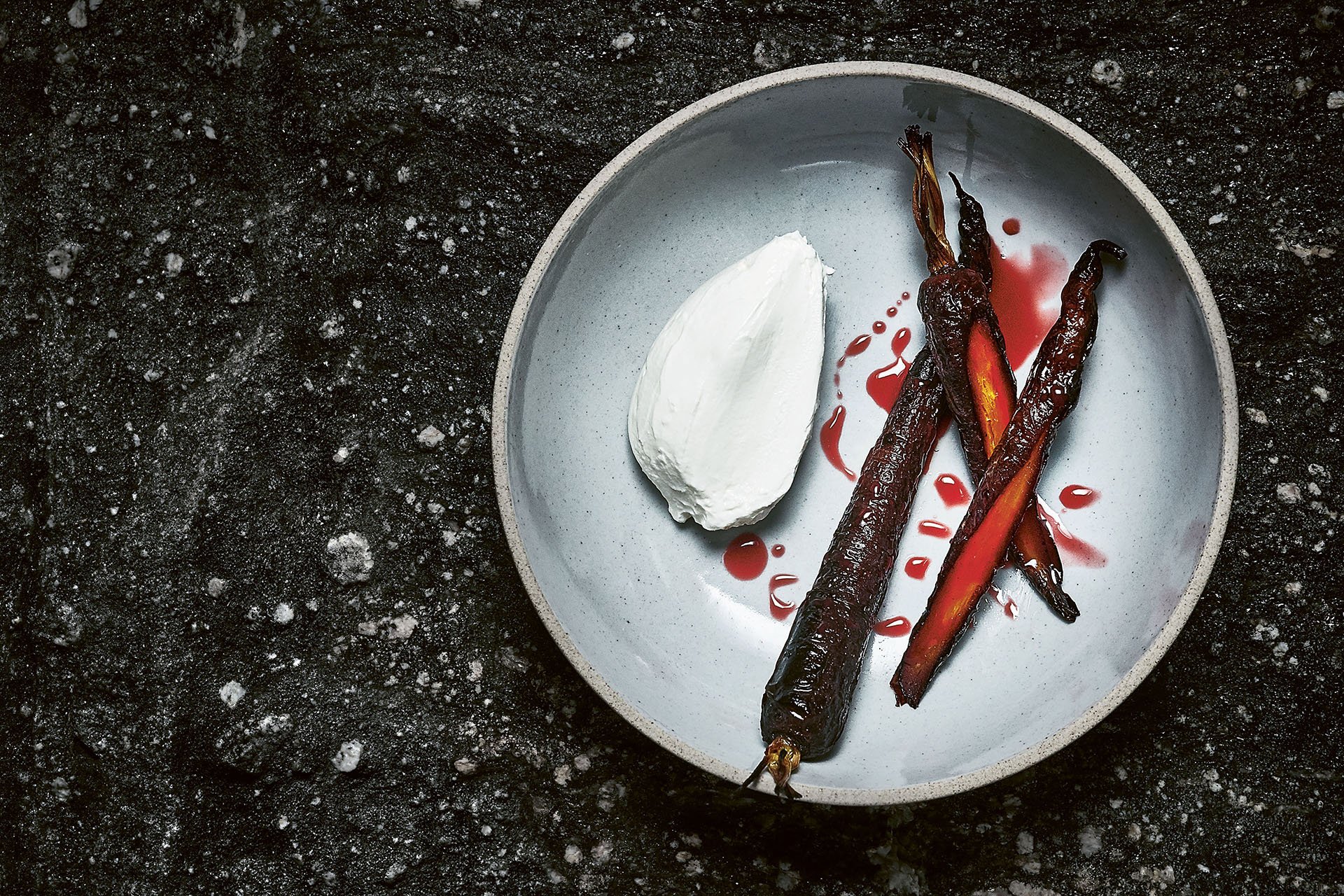Great veggie BBQ ideas from two cookbooks
There are many reasons to focus on vegetables when it comes to barbecue. First, it means eating more of the fresh, in-season produce that makes summer so delicious. (Sweet corn, I’m looking at you.) Second, it’s a great way to take a break from eating meat, which is good for the planet and helps reduce your foodprint. Thirdly, there are so many great veggie BBQ recipes to make: carrot dogs, veggie burgers and shish kebabs.
However, searching Amazon’s cookbook listings for the word barbecue, only two vegetarian-focused books come up in the first 57 listings. The definition of barbecue — “to roast or broil on a rack or revolving spit over or before a source of heat (such as hot coals)” — says nothing about meat, but the term is generally associated with cooking beef, pork and chicken. A secondary definition for the word, in fact, is “a large animal (such as a steer) roasted whole or split over an open fire or a fire in a pit.”
But, despite the general meaty associations that come with the word barbecue, there are exciting ways to cook vegetables and focusing on the grill can, pun intended, heat things up. Two cookbooks exploring the world of vegetable barbecue add more exciting recipes to the list and give us another reason to focus on vegetarian cookout fare.
“One area where meat still seems to dominate, and the vegetarians and vegans get a bit overlooked, is at the barbecue,” writes Charlotte Bailey in the introduction to her cookbook “Fresh Veggie BBQ”. “And it’s such a shame. We love barbecues, we love fire, we love being outdoors, we agree that nothing beats that smoky taste only barbecuing can achieve. And while we do love veggie burgers and we aren’t quite sick to death of halloumi just yet, the world of veggie barbecues definitely needs some fresh ideas.”
Charlotte co-wrote the book with her husband David, with whom she also runs Wholefood Heaven, their London-based food truck, and some of the recipes seem aimed at pleasing the vegetarian BBQ trends that appeal to food truck fans like sticky tempeh “ribs” and jackfruit burgers with grilled pineapple. David, the duo’s chef, grew up in South Africa and the book also includes some flavors from his childhood with dishes like bunny chow, an Indian curry, and jollof pot, a West African one-pot rice. Other dishes are drawn from the couple’s travels: a recent trip to Tel Aviv inspired a grilled eggplant sabich sandwich and a burnt cauliflower salad; their versions of elotes (grilled corn) and yakitori (skewers) are based on trips to Mexico and Japan.

For Martin Nordin, author of the book “Fire, Smoke, Green” and a former creative director for Ikea Food, vegetables are also valuable tools for becoming a better barbecue master. “Grilling vegetables and immersing myself in cooking methods and flavorings has completely changed the way I cook,” Nordin writes in his book’s introduction. “There is a greater variety and richness of taste than when you grill meat, and the flavors are deeper.”
While the presentation of his recipes skews a bit fancier than the bright colors and simple platters of “Fresh Veggie BBQ,” — the Nordin book’s fancy photos and intricate plating style call to mind a fine-dining chef rather than an Ikea food connoisseur — a closer look at “Fire, Smoke, Green” shows that a lot of his recipes and techniques are simple and easily achievable in the backyard, campfire or home kitchen. Vegetables are grilled, then tossed into salads; others are smoked and combined into soups. Some dishes, like his fermented potato tortillas, are more complicated, but the majority are accessible and promise the reward of fresh, imaginative flavor combinations.
Looking through the two cookbooks as the summer kicks off, it’s easy to get excited about grilling. Here are five techniques and ideas from the books that I’m planning to use in my vegetarian-friendly barbecues this summer.
Grill and then…
In traditional barbecue, meat is smoked or grilled and that’s usually it. The cliche vegetarian barbecue dishes mimic that concept, replacing meat with plant-based alternatives or large cuts of vegetables — portobello mushrooms, carrots, jackfruit — to produce a meat-like replacement. Instead, I’m drawn to the recipes in these books that use grilled elements to compose dishes, rather than accepting a plate of grilled vegetables as complete.
The Baileys include several such recipes in their cookbook, like mixing fire-roasted tomatoes into jambalaya, stuffing a sabich sandwich with grilled eggplant (instead of roasted or fried), and adding blackened bell pepper into their smoky campfire beans. Nordin mixes grilled cauliflower pieces into an herby gremolata salad, smoked beets into a hearty mushroom stew, and stuffs charcoal-roasted leek with brothy beans (recipe below). In each recipe, the grilled item adds a depth of flavor and richness to a final dish; while the dishes could have been made without the grill, they were made better with the additions.
While I’ve dog-eared many of the recipes in these books, including Nordin’s leek preparation below, I also want to simply add the basic premise in my cooking. When I pull out the grill or head to a cookout, I’ll think about doing double duty: what am I grilling now, and what can I grill for later? Similar to pickled ingredients, these recipes show that grilled onions, peppers, tomatoes and other vegetables can easily be added into recipes to give a boost of flavor, a smoky taste that can really enhance vegetarian dishes.

Grill everything
When vegetables are discussed in classic barbecue cookbooks, asparagus, zucchini, mushrooms, spring onions and peppers are usually the primary vegetables suggested to grill. But the recipes of both “Fresh Veggie BBQ” and “Fire, Smoke, Green” feature a much wider range of ingredients. Nordin tosses whole pea pods onto the grill, allowing the smoke to permeate the pea inside, then shelling them for his spring salad with mint and bean sprouts. And when it comes to the basic shish kebab, Nordin also thinks outside of the norm, skewering apples and Brussels sprouts together in one dish, combining grilled turnip skewers with charred kale in another.
In their recipe for barbecued vegetables and chimichurri, the Baileys grill a mix of plum tomatoes, fennel, eggplant and zucchini, encouraging readers to toss anything onto the grill. “This is a simple way to really enjoy the flavors of summer’s best vegetables,” they write in the recipe headnote. “It works with any vegetable you fancy or happen to have to hand. It’s great served as part of a larger barbecue spread with some brown rice and a few easy sides.”
This advice to think outside the typical vegetables and grill what I have will come in handy as I use-up my CSA haul each week. Right now that means trying to grill beets and char collards, but I’m really looking forward to diving deeper as summer’s produce comes into season. I’ll try grilling juicy melons, smoking strawberries and charring thick cuts of cauliflower.

Think about different heats
The image of a backyard cookout usually calls to mind a grill and fireside cooking. But barbecuing can refer to a lot of different ways to use heat, directly or indirectly. Nordin and the Baileys both teach their readers about several techniques, including smoking, salt-roasting and ember-roasting ingredients.
“I often choose to roast larger, more compact vegetables or fruits until the skin is burnt and completely black, before cooking them using indirect heat for a little longer,” writes Nordin. “This is an amazing way of producing the wonderful charred barbecue flavor while also cooking the insides without them drying out and getting boring, which can happen if you slice them and barbecue them.”
I have a summer camping trip planned later this summer and I’m set on trying out this technique, with his leek recipe below. Nordin deeply chars ingredients like pineapple or sweet potato, then slowly finishes cooking them by moving them off the direct heat source, leaving them near enough to it to continue cooking through, tucked into hot coals or wrapped in tinfoil. I also plan to try out the Baileys’ ember-roasted sweet potatoes, an easy campfire meal that turns the sweet potato into a burrito-bowl-like dish with black beans, herbs, spices and sour cream.
Veggie BBQ all year round
“At some point, I was inspired to put an aubergine [eggplant] straight into the flames and, coincidentally, a friend had made smoked tomatoes for dinner – suddenly a whole new universe had opened up to me,” writes Nordin. “I discovered new opportunities to cook vegetables using fire and smoke, and then – just as is the case with everything I get a little crazy about – I began to refine my methods and techniques. My grilling experiments were more often successful than not, and before long I was using fire and smoke to make dinner all year round.”
In the U.S., barbecuing and cookouts are often relegated to a summertime activity. But flipping through these cookbooks and reading Nordin’s words, I’m inspired to bring the flavors into my cooking year-round. Tools like a grill-plate, small indoor grill and smoker can all help make barbecuing possible year-round. Nordin suggests a Japanese hibachi grill, a small tabletop grill that can be used indoors. I’m not quite ready to purchase an indoor grill, but I do have a cast iron grill pan, which can help bring smoky char to my dishes and get me started making veggie BBQ part of my dinners year-round.

Recipe: Charcoal-roasted Leek with Calypso Beans, Smoked Onions and Fennel Broth
Martin Nordin, “Fire, Smoke, Green”
Serves 6
Ingredients
3 large leeks
150 g (5 oz/2 ½ cups) cooked kidney beans
4 Smoked Onions, (see recipe below)
Fennel broth
2 tablespoons rapeseed (canola) oil
1 yellow onion, coarsely chopped with the skin on
1 fennel bulb, coarsely chopped
2 garlic cloves, crushed with the skin on the green parts of the leeks from above (around 200 g/7 oz)
2–3 sprigs of parsley
3 star anise
1 teaspoon white peppercorns
1 teaspoon salt
300 ml (10 fl oz/1 ¼ cups) water
To serve
fennel flowers or fennel dill [ed. note: Fennel dill is commonly referred to as fennel fronds in the US.]
Method
1. Start with the broth. Heat up the oil in a saucepan on a medium heat, add the onion and leave to simmer until it begins to soften. Add the rest of the ingredients except the water and fry while stirring – they should not take on any colour. Pour the water in after around 15 minutes and bring to the boil. Let the broth simmer for around 30 minutes so that it reduces down slightly. Strain and set aside.
2. Add charcoal or firewood to half the barbecue (grill) so that you have space to roast the leeks using indirect heat later. Light the barbecue and once it is burning strongly, place the leeks straight onto the charcoal so that the outer layer burns. Pick up the leeks, place on the grill and position them on the charcoal-free side. Close the lid and roast using indirect heat for 20–30 minutes until the leeks are soft all the way through. You can measure the core temperature – it should preferably be above 95ºC (200ºF).
3. Reheat the broth, add the beans and the Smoked Onions and leave to simmer for a while. Cut the leeks in half and make an incision lengthways on each half. Fill with the beans and broth and garnish with a few fennel flowers.
Recipe: Smoked Onions
Martin Nordin, “Fire, Smoke, Green”
Ingredients
500 g (1 lb 2 oz) onions, halved
1 garlic bulb, halved widthways
fresh mixed herbs, e.g. rosemary and thyme
rind of 1 unwaxed lemon
200 ml (7 fl oz/scant 1 cup) rapeseed (canola) oil
1/2 teaspoon salt
100–200 g (3 ½ –7 oz) smoker chips
Method
1. Light the barbecue (grill). Get a large baking tray and a smaller heatproof plate with a 1–11/2 cm (1/2 in) high edge (the edge cannot be higher than the one on the large baking tray). Place a thin layer of smoker chips in the bottom of the large baking tray then place the smaller plate in the tray.
2. Position the onions with the cut-side facing upwards together with the garlic, herbs and lemon rind on the smaller plate. Drizzle with the oil and sprinkle with the salt. Cover with kitchen foil and place the baking tray with the plate on the grill while there are still flames. After a few minutes, the chips will begin to smoke and the smoke will seep out from under the foil (if the smoke doesn’t seep out, you can unfold the foil a little at one corner to check it is smoking). Remove the baking tray from the grill when it begins to smoke and leave it to stand on the ground for a few minutes. Repeat this step three to four times. Remove the foil to check whether the onions and oil have taken on colour. Otherwise, repeat the procedure a few more times.
3. Place the onions in a sterilised glass jar, pour the oil over and seal the jar. If you like, you can fry the onions quickly in some oil just before serving – this will add heat to the onions and the flavours will blossom once again.
Recipe excerpted with permission from “Fire, Smoke, Green” by Martin Nordin, published by Hardie Grant Books April 2020, RRP $24.99 Hardcover.
Top photo of Grilled Peas and Spring Onions from “Fire, Smoke, Green” by Martin Nordin.
More Reading
15+ ideas for delicious meatless grilling
July 1, 2025
4 Tips for Stretching Your Food Dollars
April 16, 2025
How to use extra onions
April 9, 2025
Our latest podcast episode on pistachios: The making of a food trend
April 1, 2025
This vegan tiramisu will bring you joy
March 11, 2025
For lessons in thrifty, climate-friendly cooking, look to vintage cookbooks
March 10, 2025
Americans love olive oil. Why doesn't the U.S. produce more of it?
February 28, 2025
How to fight household food waste? Join our Eat Down Your Pantry Challenge!
February 13, 2025
During a period of egg chaos, egg replacements for (almost) any situation
February 7, 2025
Ways to go meatless — or less-meat — in January
January 15, 2025
